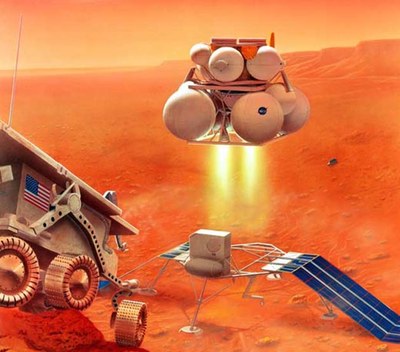Bring home the sampleby Lou Friedman
|
| Although Mars Sample Return has made it into official planning documents and schedules, some financial crisis always arises to set it back another half-decade or so. |
Automated (robotic) sample return is no mean achievement. In the entire space age automated sample return has been done from a planetary surface only four times: three missions by the now historical Soviet Union from the Moon and once by the Japanese from the near Earth asteroid Itokawa. It’s never yet by NASA, although that may be about to change (see below). The Soviet Luna missions were remarkable. In the 1970s they conducted sample return missions that all the space agencies in the world now find too hard and costly to do. They did it not just once but three times (out of four tries), returning approximately 300 grams of lunar samples. Their achievement, though, was dwarfed by the Apollo missions and is barely recognized now: few Russians even know of it, and I have (sadly) met many younger people in the space program today who are unaware that the missions took place.
One thing you have to like about the Russian aerospace approach is they keep using what works. The Luna sample return spacecraft has influenced the design of their Phobos sample return (Phobos-Grunt), scheduled for launch this fall. It remains to be determined whether the terrific Soviet experience from the old days will compensate for their lack of performance in planetary exploration during the past two decades (since the only partial success of one of their 1988–89 Phobos missions).
The Japanese Hayabusa sample return from Itokawa was also a remarkable mission: an adventure worthy of an action movie (if the seven-year flight were packed into 90 minutes on the big screen). It showed how difficult a sample return really is, with so many operations to perform in sequence with several different spacecraft. The mission operations team from the Japan Aerospace Exploration Agency (JAXA) was outstanding, rescuing the mission several times over its lifetime.
The Russian and Japanese experiences—especially those with the mission operations and command and control teams—included important lessons to be learned for future sample returns. We already mentioned this year’s upcoming launch of Phobos-Grunt. In addition to that mission’s many science objectives, the engineering experience for planning future Mars sample return will be important. I emphasized this aspect of it when we first proposed the Planetary Society’s Living Interplanetary Flight Experiment (LIFE) that will be included in the Phobos Sample Return mission. The microorganisms we placed in the return capsule for the round trip will be the first life from Earth purposely sent to another world. If and when it returns, the protocols for handling LIFE will provide valuable experience for Mars sample return planning—even thought the life obviously is from Earth and not extraterrestrial.
| Mars sample return could provide a strong interim international cooperation objective, with earlier results and an exciting and engaging mission for public interest. |
NASA will soon have its own chance to launch its first robotic sample return mission to another world. The OSIRIS-REx mission selected in the most recent New Frontiers science mission competition is a near Earth asteroid sample return. It is slated to launch in 2016 for a mission to an asteroid, currently named 1999 RQ36. (Part of the Planetary Society’s role in the mission is to run a competiton to rename the asteroid.) Unlike Hayabusa, which actually landed on Itokawa, OSIRIS-REx will rendezvous with 1999 RQ36 and then extend an arm to grab the sample. Thus there will be no lander vehicle. Still, the mission is challenging, and I congratulate Mike Drake at the University of Arizona and the entire mission team on their selection, wishing them the best of luck on their mission development.
I hope OSIRIS-REx and Phobos-Grunt help build the momentum for Mars Sample Return. As I noted, the political difficulty in getting such a mission approved is extraordinary. But mission designers are clever and have now come up with ways to not only spread the costs and development over several Martian opportunities, but also to produce interim objectives so that not all the eggs of mission success will be in one basket of return.
NASA and the European Space Agency are merging their Martian surface exploration goals and plan to carry out sample return together. That will help, but the current economic situation may still postpone plans again. Perhaps Russia and Japan should be made part of a truly international effort to return a Martian sample. This, in my view, would be an ideal international initiative to follow the International Space Station, a stepping-stone for the eventual human mission to Mars. There is plenty to do, and Russian expertise with a return rocket or with a lander of their own could be added to the European and American planning to produce a more robust mission plan that is also more affordable, since many nations will share the cost. Japanese experience with sampling would also add to such a mission.
Exploration as a goal in the space program needs some wind in its sails. The political conundrum of the human program is going to be with us for at least another decade. Mars sample return could provide a strong interim international cooperation objective, with earlier results and an exciting and engaging mission for public interest.
